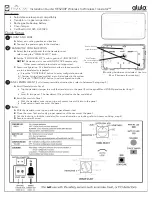
Section 6 — Effect Parameters
Edit/Effect Parameters
27
ROM-36 EQ+TREM+DDL
EQ+TREM+DDL combines a tremolo effect, which is a pulsating change in volume, with an EQ
and a digital delay.
EQ+TREM+DDL Signal Routing
BUS1 Left
BUS2
BUS1 Right
R
L
Main
Outputs
Echo
Delay
Echo
Level
Input Level Trim
EQ
EQ
Tremolo
Tremolo
Regen
The signal enters an input level trim (EQ TRIM) followed by a programmable EQ, and is then
routed to the tremolo. The tremolo is routed directly to the output. The left channel signal
passes through the digital delay and is routed back into the delay. There is another signal from
the delay that is routed to the output on the right side. One regen parameter (DELAY
FEEDBACK) between the delay sends controls the left and right delay level. This constitutes the
“ping-pong” effect. There are two echoes that are sent to the left and right outputs respectively.
The signal from the two discrete echoes has one level control. There is also an external dry signal
(not shown) that goes directly from the input to the output (BUS3). The parameters available for
this algorithm are:
BUS1 DLY AFT TREM
Range:
0 to 99
This parameter determines how much of the signal that is sent to BUS 1 (the tremolo) will also go
to the delay — it is a delay mix for the tremolo signal.
BUS2 DELAY MIX
Range:
0 to 99
This parameter controls the Dry/Wet mix of the delay for voices sent to BUS2. There is no
tremolo routed to BUS2 (see diagram).
TREM RATE
Range:
0 to 99
This parameter sets the rate of modulation. Mid values create a faster wavering sound. This
parameter, when used in conjunction with the SAMPLE/HOLD RATE parameter, can create
some interesting staccato effects.
DEPTH
Range:
0 to 99
This parameter sets the depth of amplitude modulation.
L/R LFO
Range:
OUT-OF-PHASE or IN-PHASE
This parameter controls whether the left and right channels of the stereo tremolo will modulate
IN-PHASE or OUT-OF-PHASE.
SAMPLE/HOLD RATE
Range:
0 to 100
This parameter controls the sample rate of a sample and hold network applied to the LFO within
the tremolo. When in “Hold,” the effect will be to fix the instantaneous amplitude (if the depth is
not 0). A setting of 1 will have the largest space between holds. Lower settings create a staccato
effect, whereas higher values will increase the amount of samples, making the tremolo flow more
smoothly. This parameter can also be turned off (when set to 0).
















































